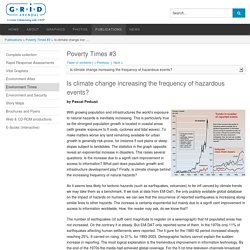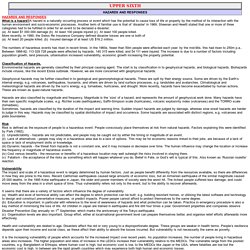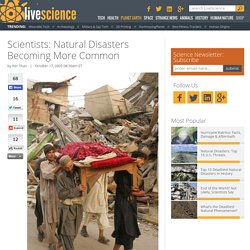

Key words. Is climate change increasing the frequency of hazardous events? By Pascal Peduzzi With growing population and infrastructures the world’s exposure to natural hazards is inevitably increasing.

This is particularly true as the strongest population growth is located in coastal areas (with greater exposure to fl oods, cyclones and tidal waves). To make matters worse any land remaining available for urban growth is generally risk-prone, for instance fl ood plains or steep slopes subject to landslides. The statistics in the graph opposite reveal an exponential increase in disasters. This raises several questions. As it seems less likely for tectonic hazards (such as earthquakes, volcanoes) to be infl uenced by climate trends we may take them as a benchmark. The number of earthquakes (of suffi cient magnitude to register on a seismograph) that hit populated areas has not increased. The second sharp increase appears in the mid-1990s (circa 1995). Hazard event prediction. HAZARDS AND RESPONSES. HAZARDS AND RESPONSESWhat is a hazard?

A hazard is a naturally occurring process or event which has the potential to cause loss of life or property by the method of its interaction with the human environment and socio-economic processes. Another term of familiar use is that of ‘disaster’ in 1969, Sheenan and Hewitt stated that one or more of three categories had to be fulfilled in order for an event to be declared a disaster;(a) At least $1 000 000 damage (b) At least 100 people injured (c) At least 100 people killed.More recently, in 1990, the Swiss Re Insurance Company defined disaster losses are one or both of(a) At least 20 people killed. (b) Insured damage of at least US $16.2 million. The numbers of hazardous events has risen in recent times.
In the 1960s, fewer than 50m people were affected each year; by the mid-90s, this had risen to 250m p.a.. Classification of Hazards.Environmental hazards are generally classified by their principal causing agent. The number of tectonic hazards is not increasing but their impact has become more disastrous. 4.0 Volcanic Eruptions. 4.1 Montserrat.

The Montserrat eruption occurred from 1995 1997 in the Soufriere Hills area of Montserrat in the Caribbean. It occurred on the North American and Caribbean plates where the Caribbean was being subducted. The volcano had been dormant for 400 years previous to this eruption. This eruption resulted in 23 deaths and the evacuation of 50% of the islands population to the north of the island to makeshift shelters. Rioting broke out due to the belief that the government weren’t doing enough to help their citizens. £41 million was given in aid by the UK government and the mvo was set up to further monitor the volcano and help to prevent further disasters. 4.2 Mount Pinatubo.
Th 1991 on the boundary between the Eurasian and Philippines plates in the Philippines. 2010. Most developed country in the world (United Nations Human Development Index) and 4 most productive per capita due to its free market economy and it has the 2. Scientists: Natural Disasters Becoming More Common. Earth might seem like a more active and dangerous place than ever, given the constant media reports of multiple natural disasters recently.

But a broader view reveals that it's not Mother Nature who's changed, but we humans. Drawn by undeveloped land and fertile soil, people are flocking to disaster-prone regions. This creates a situation in which ordinary events like earthquakes and hurricanes become increasingly elevated to the level of natural disasters that reap heavy losses in human life and property.
Meanwhile, in any given year, the death toll at the hands of Mother Nature varies greatly, as do the sorts of major deadly events. How we die Of the estimated 61,000 people who have died this year due to natural disasters, about 50,000 (according to today's estimate) were victims of the 7.6 earthquake that struck Pakistan Oct. 7. Other natural disasters for 2005 that have resulted in a major loss of life include: Disasters increasing What's going on? Making disasters. Top Ten Natural Disasters.